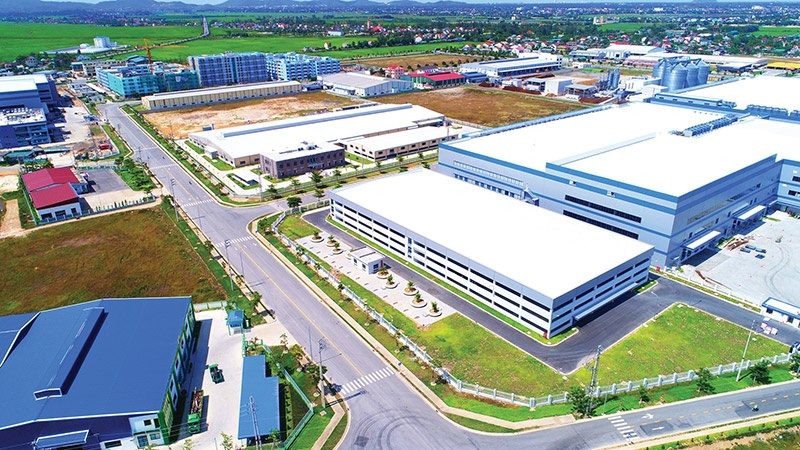Large-scale industrial real estate surge projected
 |
| Large-scale industrial real estate surge projected - illustration photo |
Through negotiation and execution of various free trade agreements, Vietnam is gradually integrating into the global economy. These agreements will expand opportunities for capital investment in supporting industries, manufacturing industries, added-value industries, and high-tech content industries. As a result, Vietnam may attract more European, South Korean, Japanese, and Chinese investors to build factories, enabling the growth of industrial real estate.
Many large-scale mergers and acquisitions (M&A) occurred in industrial real estate, with a predominance of foreign-invested enterprises (FIEs), as FIEs with a financial advantage will choose to stay ahead through M&A with domestic enterprises with available land funds and projects that have been essentially completed in terms of investment regulations. Foreign investors are particularly interested in purchasing and increasing land funds in Vietnam’s major industrial areas.
Most international groups that engage in mergers in Vietnam form joint ventures to maximise the benefits of both foreign and local partners. The foreign party has most of the decision-making authority in this model, while Vietnamese investors give legal backing.
With the purpose of owning and developing 240,000 square metres in My Phuoc 4 Industrial Park (IP) in Ho Chi Minh City, ESR Cayman Ltd. entered the Vietnamese market by forming a joint venture with BW Industrial Development JSC.
Under the Law on Competition 2018, a joint venture is defined as economic concentration, and is thus subject to consideration by the competition authority of Vietnam if the transaction meets the notification threshold.
In terms of cost-benefit ratios, joint ventures cover a wide range, with costs referring to anti-competitive consequences and benefits referring to pro-competitive efficiency. Many joint ventures should be subjected to a competition review based on a detailed assessment of pro- and anti-competitive impacts. Joint ventures that have overall pro-competitive impacts should be allowed, but the same cannot be said for any anti-competitive limitations they may include.
Theoretically, a joint venture will be seen as posing less of a danger to competition than a full merger of the parents if the production joint venture retains the assets, abilities, and motivations of the parents to compete independently of one another and of the production joint venture. As a result, legislators and antitrust authorities have favoured joint ventures over mergers because they allow for the continued existence of the parents and potentially continued competition between the parents; and, in comparison to mergers, joint venture agreements are more easily modified or dismantled later.
Joint ventures, it is claimed, promote the application of scientific advancement, and keep up with development trends in the industrial real estate segment to reduce costs, improve the quality of products and services, and ultimately bring better benefits to consumers and the community, such as factory 4.0 and high-rise factory models.
Factory 4.0 uses a variety of sophisticated technological equipment to minimise expenses and operating time, optimise storage space, and improve warehouse operational efficiency. Some of the technology gadgets used to help businesses manage and monitor close to the warehouse remotely include rooftop solar power systems, digitalisation and automation devices, and simple phone applications.
High-rise factory models have also started to arise in places with limited industrial land supply to provide more storage space for e-commerce enterprises’ demands. Traditional factories are often built at the ground or lower levels, but the leasing or construction costs of this style of factories are quite costly since it occupies such a huge space, especially for newly established businesses, pilot projects, or new businesses entering the market.
High-rise factories are created and equipped with all necessary equipment (elevators for transferring goods), reduce costs, and are a viable choice for satisfying the needs of the market’s small- and medium-sized businesses.
What the stars mean:
★ Poor ★ ★ Promising ★★★ Good ★★★★ Very good ★★★★★ Exceptional
Related Contents
Latest News
More News
- Sun Group breaks ground on $2 billion Van Don casino complex (December 19, 2025 | 18:14)
- Rare, beautiful, sustainable: the mark of iconic real estate (December 19, 2025 | 08:00)
- Owner-occupied housing stabilises, paving the way for new growth cycle (December 18, 2025 | 17:04)
- Unlocking urban potential of smart cities (December 18, 2025 | 16:50)
- Green finance offers 'passport' for Vietnamese construction, building materials firms (December 15, 2025 | 08:00)
- Gamuda Land commit long-term investment (December 12, 2025 | 11:49)
- HITC ties up with Evolution to develop AI and hyperscale data centres in Vietnam (December 11, 2025 | 12:09)
- Real estate deals boom via high-profile names (December 08, 2025 | 11:32)
- Industrial segment shaped by M&As (December 08, 2025 | 08:00)
- The Privé sets the benchmark for luxury real estate (December 05, 2025 | 08:28)

 Tag:
Tag:





















 Mobile Version
Mobile Version